2022 HYUNDAI VELOSTER light
[x] Cancel search: lightPage 256 of 446
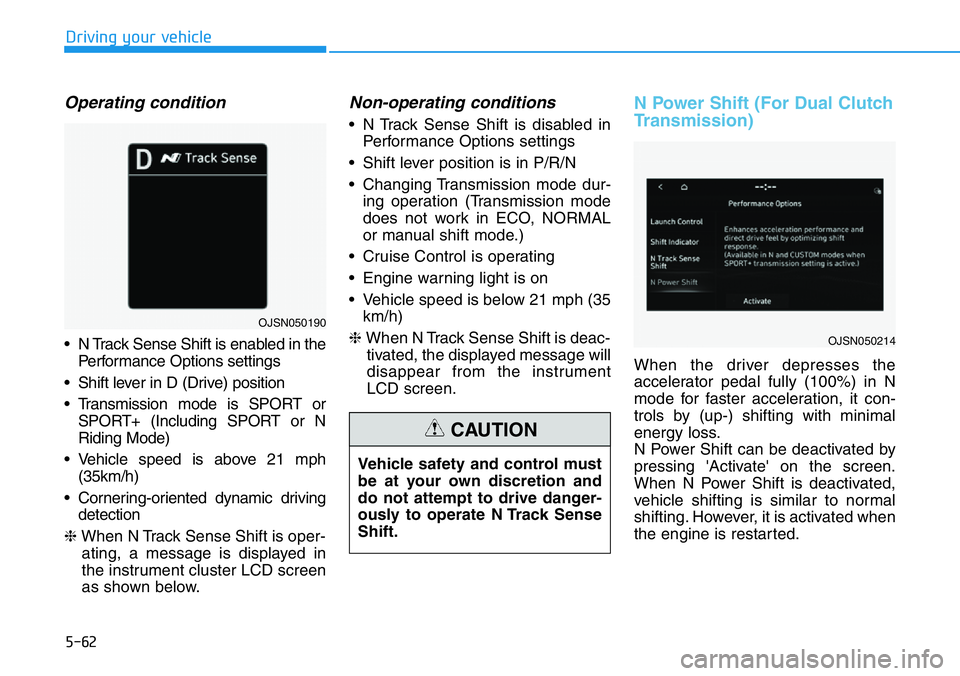
5-62
Driving your vehicle
Operating condition
• N Track Sense Shift is enabled in the
Performance Options settings
• Shift lever in D (Drive) position
• Transmission mode is SPORT or
SPORT+ (Including SPORT or N
Riding Mode)
• Vehicle speed is above 21 mph
(35km/h)
• Cornering-oriented dynamic driving
detection
❈When N Track Sense Shift is oper-
ating, a message is displayed in
the instrument cluster LCD screen
as shown below.
Non-operating conditions
• N Track Sense Shift is disabled in
Performance Options settings
• Shift lever position is in P/R/N
• Changing Transmission mode dur-
ing operation (Transmission mode
does not work in ECO, NORMAL
or manual shift mode.)
• Cruise Control is operating
• Engine warning light is on
• Vehicle speed is below 21 mph (35
km/h)
❈When N Track Sense Shift is deac-
tivated, the displayed message will
disappear from the instrument
LCD screen.
N Power Shift (For Dual Clutch
Transmission)
When the driver depresses the
accelerator pedal fully (100%) in N
mode for faster acceleration, it con-
trols by (up-) shifting with minimal
energy loss.
N Power Shift can be deactivated by
pressing 'Activate' on the screen.
When N Power Shift is deactivated,
vehicle shifting is similar to normal
shifting. However, it is activated when
the engine is restarted. Vehicle safety and control must
be at your own discretion and
do not attempt to drive danger-
ously to operate N Track Sense
Shift.
CAUTION
OJSN050214
OJSN050190
Page 258 of 446

5-64
Driving your vehicle
Basic function
Forward Collision-Avoidance Assist
is designed to help detect and moni-
tor the vehicle ahead or help detect a
pedestrian in the roadway and warn
the driver that a collision is imminent
with a warning message and an
audible warning, and if necessary,
apply emergency braking.
Detecting sensor
[1] : Front view camera
Refer to the picture above for the
detailed location of the detecting
sensor.
FORWARD COLLISION-AVOIDANCE ASSIST (FCA) (FRONT VIEW CAMERA ONLY)
(IF EQUIPPED)
OTM070237OBU050218N
Take the following precautions
to maintain optimal perform-
ance of the detecting sensor:
•Never disassemble the detect-
ing sensor or sensor assem-
bly, or apply any impact on it.
•If the detecting sensors have
been replaced or repaired, we
recommend that you have
your vehicle inspected by an
authorized HYUNDAI dealer.
•Never install any accessories
or stickers on the front wind-
shield, or tint the front wind-
shield.
•Pay extreme caution to keep
the front view camera dry.
•Never place any reflective
objects (i.e. white paper, mir-
ror) over the dashboard. Any
light reflection may prevent
the system from functioning
properly.
CAUTION
Page 259 of 446
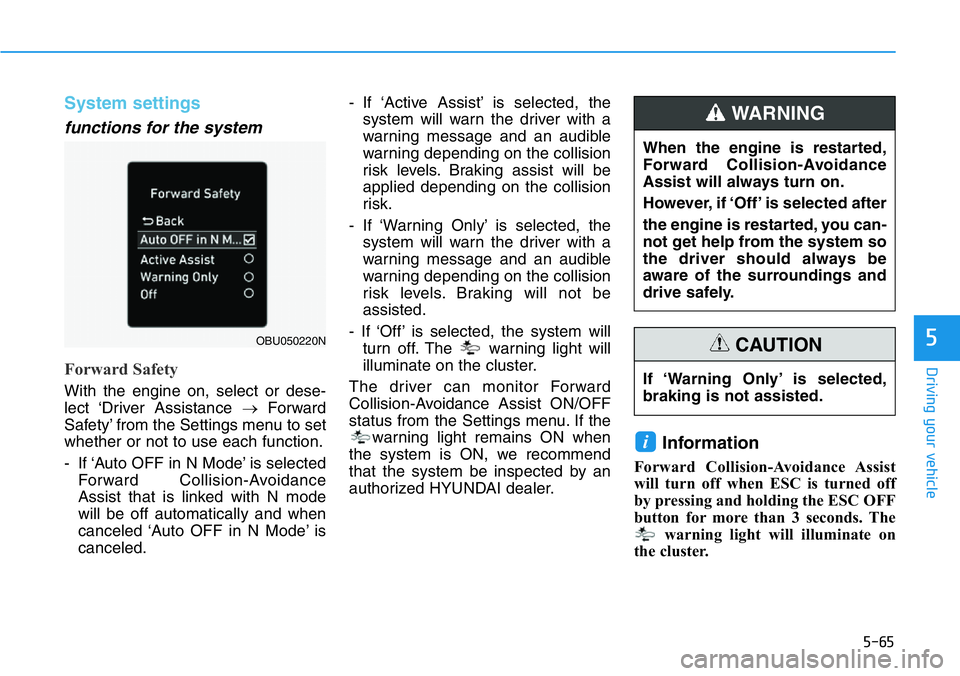
5-65
Driving your vehicle
5
System settings
functions for the system
Forward Safety
With the engine on, select or dese-
lect ‘Driver Assistance →Forward
Safety’ from the Settings menu to set
whether or not to use each function.
- If ‘Auto OFF in N Mode’ is selected
Forward Collision-Avoidance
Assist that is linked with N mode
will be off automatically and when
canceled ‘Auto OFF in N Mode’ is
canceled.- If ‘Active Assist’ is selected, the
system will warn the driver with a
warning message and an audible
warning depending on the collision
risk levels. Braking assist will be
applied depending on the collision
risk.
- If ‘Warning Only’ is selected, the
system will warn the driver with a
warning message and an audible
warning depending on the collision
risk levels. Braking will not be
assisted.
- If ‘Off’ is selected, the system will
turn off. The warning light will
illuminate on the cluster.
The driver can monitor Forward
Collision-Avoidance Assist ON/OFF
status from the Settings menu. If the
warning light remains ON when
the system is ON, we recommend
that the system be inspected by an
authorized HYUNDAI dealer.
Information
Forward Collision-Avoidance Assist
will turn off when ESC is turned off
by pressing and holding the ESC OFF
button for more than 3 seconds. The
warning light will illuminate on
the cluster.
i
OBU050220N
If ‘Warning Only’ is selected,
braking is not assisted.
CAUTION
When the engine is restarted,
Forward Collision-Avoidance
Assist will always turn on.
However, if ‘Off’ is selected after
the engine is restarted, you can-
not get help from the system so
the driver should always be
aware of the surroundings and
drive safely.
WARNING
Page 260 of 446
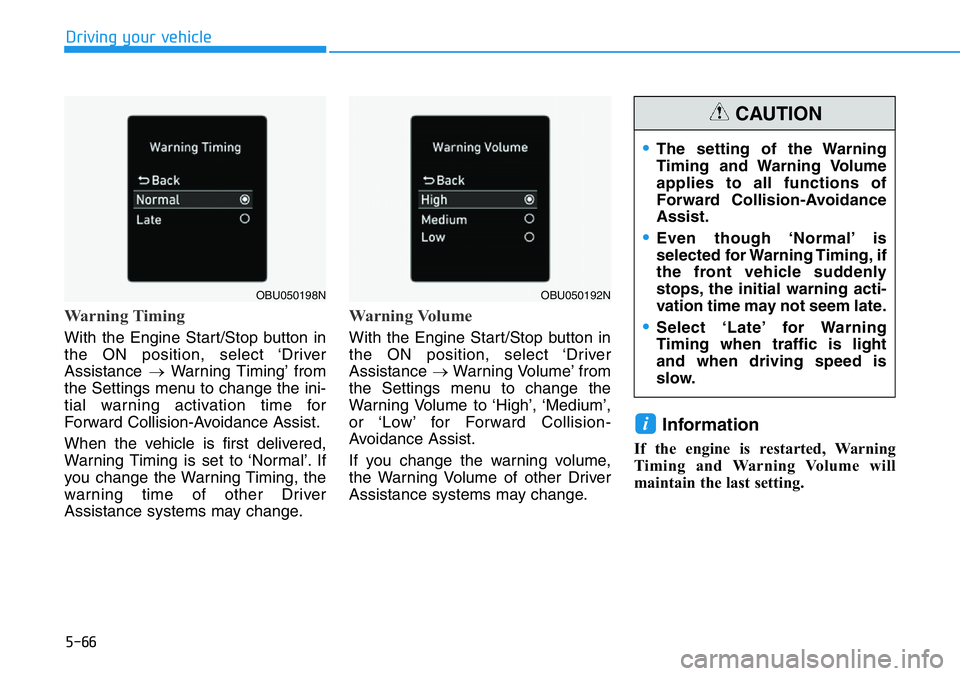
5-66
Driving your vehicle
Warning Timing
With the Engine Start/Stop button in
the ON position, select ‘Driver
Assistance →Warning Timing’ from
the Settings menu to change the ini-
tial warning activation time for
Forward Collision-Avoidance Assist.
When the vehicle is first delivered,
Warning Timing is set to ‘Normal’. If
you change the Warning Timing, the
warning time of other Driver
Assistance systems may change.
Warning Volume
With the Engine Start/Stop button in
the ON position, select ‘Driver
Assistance →Warning Volume’ from
the Settings menu to change the
Warning Volume to ‘High’, ‘Medium’,
or ‘Low’ for Forward Collision-
Avoidance Assist.
If you change the warning volume,
the Warning Volume of other Driver
Assistance systems may change.
Information
If the engine is restarted, Warning
Timing and Warning Volume will
maintain the last setting.
i
OBU050198NOBU050192N
•The setting of the Warning
Timing and Warning Volume
applies to all functions of
Forward Collision-Avoidance
Assist.
•Even though ‘Normal’ is
selected for Warning Timing, if
the front vehicle suddenly
stops, the initial warning acti-
vation time may not seem late.
•Select ‘Late’ for Warning
Timing when traffic is light
and when driving speed is
slow.
CAUTION
Page 262 of 446
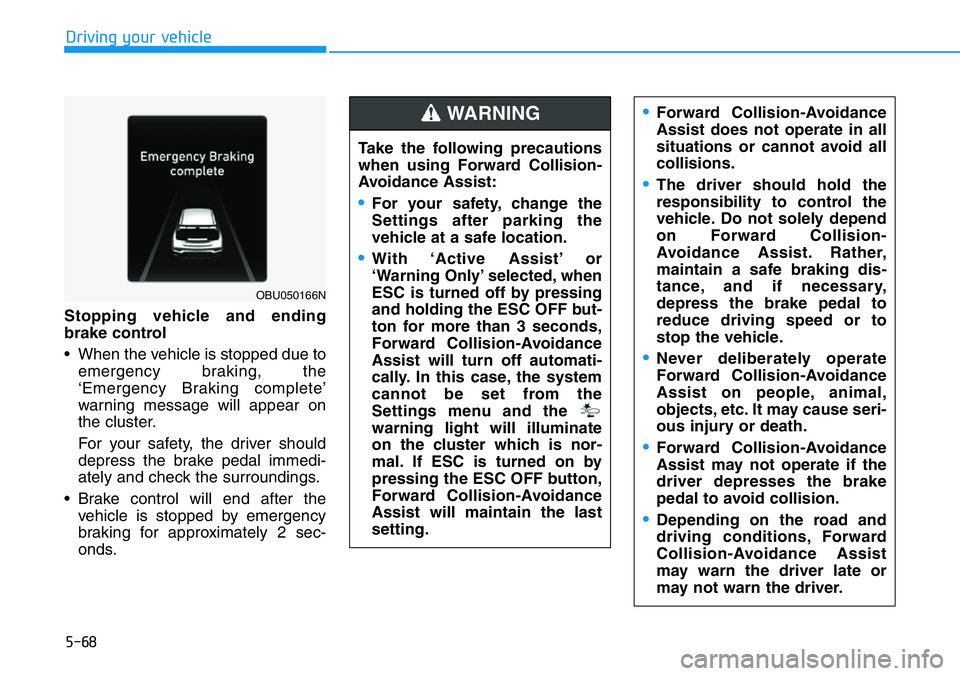
5-68
Driving your vehicle
Stopping vehicle and ending
brake control
• When the vehicle is stopped due to
emergency braking, the
‘Emergency Braking complete’
warning message will appear on
the cluster.
For your safety, the driver should
depress the brake pedal immedi-
ately and check the surroundings.
• Brake control will end after the
vehicle is stopped by emergency
braking for approximately 2 sec-
onds.
OBU050166N
Take the following precautions
when using Forward Collision-
Avoidance Assist:
•For your safety, change the
Settings after parking the
vehicle at a safe location.
•With ‘Active Assist’ or
‘Warning Only’ selected, when
ESC is turned off by pressing
and holding the ESC OFF but-
ton for more than 3 seconds,
Forward Collision-Avoidance
Assist will turn off automati-
cally. In this case, the system
cannot be set from the
Settings menu and the
warning light will illuminate
on the cluster which is nor-
mal. If ESC is turned on by
pressing the ESC OFF button,
Forward Collision-Avoidance
Assist will maintain the last
setting.
WARNING •Forward Collision-Avoidance
Assist does not operate in all
situations or cannot avoid all
collisions.
•The driver should hold the
responsibility to control the
vehicle. Do not solely depend
on Forward Collision-
Avoidance Assist. Rather,
maintain a safe braking dis-
tance, and if necessary,
depress the brake pedal to
reduce driving speed or to
stop the vehicle.
•Never deliberately operate
Forward Collision-Avoidance
Assist on people, animal,
objects, etc. It may cause seri-
ous injury or death.
•Forward Collision-Avoidance
Assist may not operate if the
driver depresses the brake
pedal to avoid collision.
•Depending on the road and
driving conditions, Forward
Collision-Avoidance Assist
may warn the driver late or
may not warn the driver.
Page 264 of 446
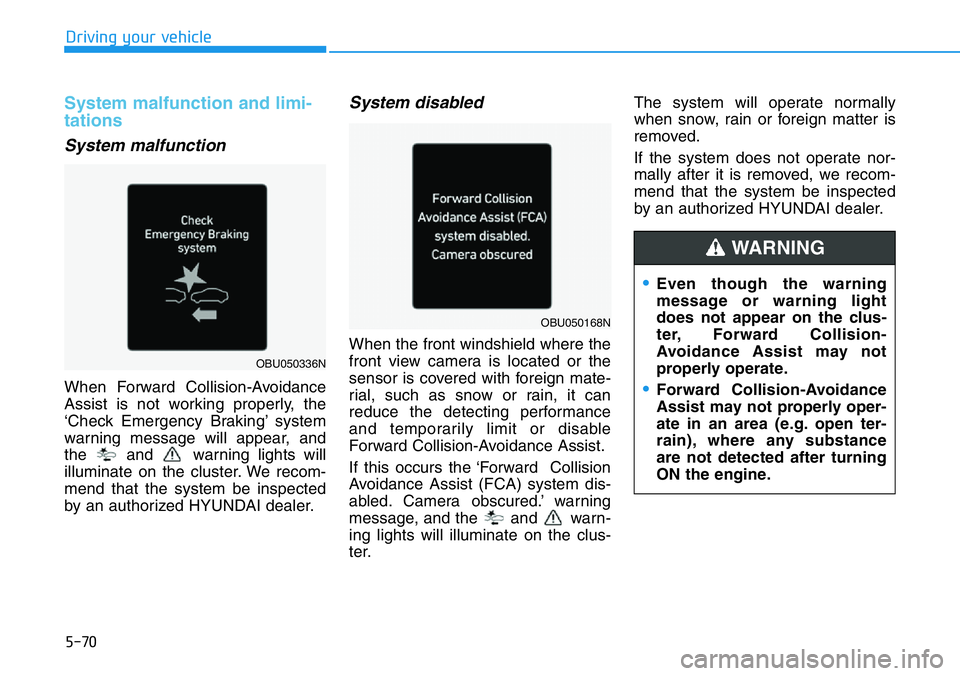
5-70
Driving your vehicle
System malfunction and limi-
tations
System malfunction
When Forward Collision-Avoidance
Assist is not working properly, the
‘Check Emergency Braking’ system
warning message will appear, and
the and warning lights will
illuminate on the cluster. We recom-
mend that the system be inspected
by an authorized HYUNDAI dealer.
System disabled
When the front windshield where the
front view camera is located or the
sensor is covered with foreign mate-
rial, such as snow or rain, it can
reduce the detecting performance
and temporarily limit or disable
Forward Collision-Avoidance Assist.
If this occurs the ‘Forward Collision
Avoidance Assist (FCA) system dis-
abled. Camera obscured.’ warning
message, and the and warn-
ing lights will illuminate on the clus-
ter.The system will operate normally
when snow, rain or foreign matter is
removed.
If the system does not operate nor-
mally after it is removed, we recom-
mend that the system be inspected
by an authorized HYUNDAI dealer.
•Even though the warning
message or warning light
does not appear on the clus-
ter, Forward Collision-
Avoidance Assist may not
properly operate.
•Forward Collision-Avoidance
Assist may not properly oper-
ate in an area (e.g. open ter-
rain), where any substance
are not detected after turning
ON the engine.
WARNING
OBU050336N
OBU050168N
Page 265 of 446
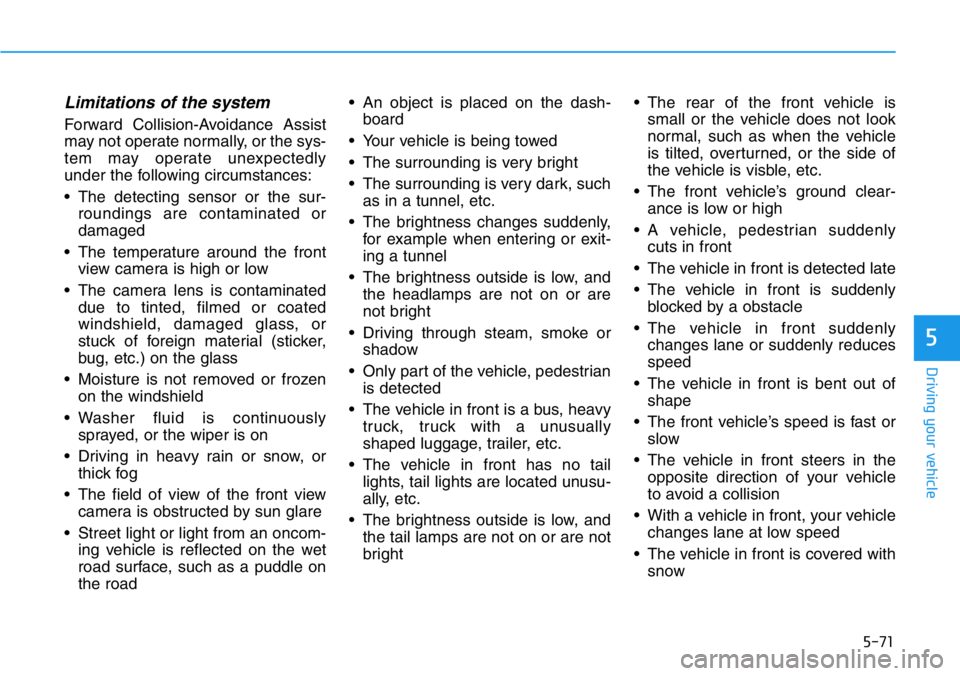
5-71
Driving your vehicle
5
Limitations of the system
Forward Collision-Avoidance Assist
may not operate normally, or the sys-
tem may operate unexpectedly
under the following circumstances:
• The detecting sensor or the sur-
roundings are contaminated or
damaged
• The temperature around the front
view camera is high or low
• The camera lens is contaminated
due to tinted, filmed or coated
windshield, damaged glass, or
stuck of foreign material (sticker,
bug, etc.) on the glass
• Moisture is not removed or frozen
on the windshield
• Washer fluid is continuously
sprayed, or the wiper is on
• Driving in heavy rain or snow, or
thick fog
• The field of view of the front view
camera is obstructed by sun glare
• Street light or light from an oncom-
ing vehicle is reflected on the wet
road surface, such as a puddle on
the road• An object is placed on the dash-
board
• Your vehicle is being towed
• The surrounding is very bright
• The surrounding is very dark, such
as in a tunnel, etc.
• The brightness changes suddenly,
for example when entering or exit-
ing a tunnel
• The brightness outside is low, and
the headlamps are not on or are
not bright
• Driving through steam, smoke or
shadow
• Only part of the vehicle, pedestrian
is detected
• The vehicle in front is a bus, heavy
truck, truck with a unusually
shaped luggage, trailer, etc.
• The vehicle in front has no tail
lights, tail lights are located unusu-
ally, etc.
• The brightness outside is low, and
the tail lamps are not on or are not
bright • The rear of the front vehicle is
small or the vehicle does not look
normal, such as when the vehicle
is tilted, overturned, or the side of
the vehicle is visble, etc.
• The front vehicle’s ground clear-
ance is low or high
• A vehicle, pedestrian suddenly
cuts in front
• The vehicle in front is detected late
• The vehicle in front is suddenly
blocked by a obstacle
• The vehicle in front suddenly
changes lane or suddenly reduces
speed
• The vehicle in front is bent out of
shape
• The front vehicle’s speed is fast or
slow
• The vehicle in front steers in the
opposite direction of your vehicle
to avoid a collision
• With a vehicle in front, your vehicle
changes lane at low speed
• The vehicle in front is covered with
snow
Page 266 of 446
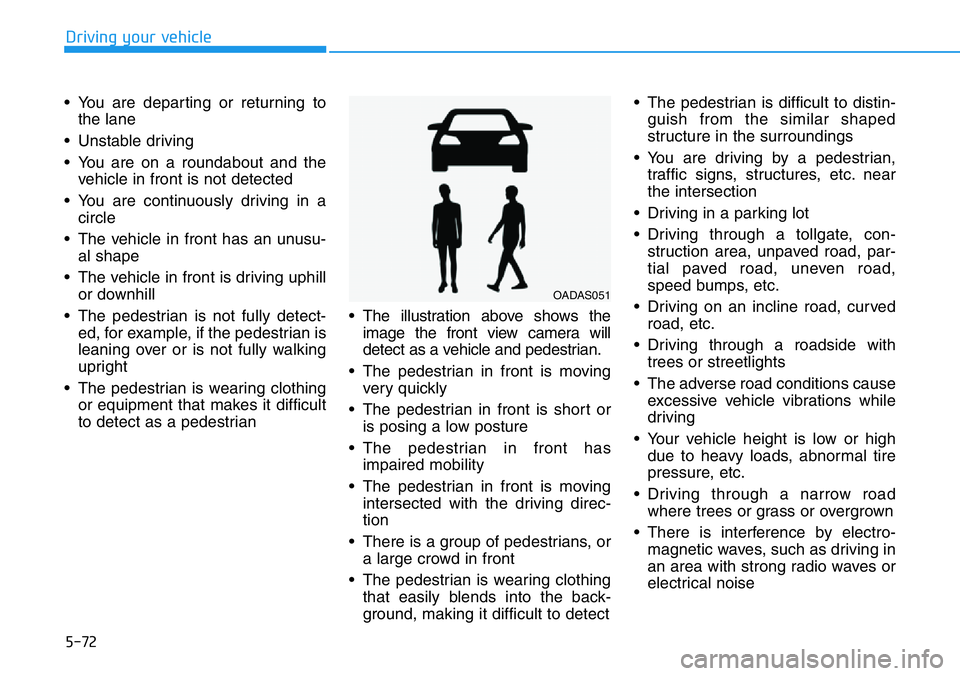
5-72
Driving your vehicle
• You are departing or returning to
the lane
• Unstable driving
• You are on a roundabout and the
vehicle in front is not detected
• You are continuously driving in a
circle
• The vehicle in front has an unusu-
al shape
• The vehicle in front is driving uphill
or downhill
• The pedestrian is not fully detect-
ed, for example, if the pedestrian is
leaning over or is not fully walking
upright
• The pedestrian is wearing clothing
or equipment that makes it difficult
to detect as a pedestrian• The illustration above shows the
image the front view camera will
detect as a vehicle and pedestrian.
• The pedestrian in front is moving
very quickly
• The pedestrian in front is short or
is posing a low posture
• The pedestrian in front has
impaired mobility
• The pedestrian in front is moving
intersected with the driving direc-
tion
• There is a group of pedestrians, or
a large crowd in front
• The pedestrian is wearing clothing
that easily blends into the back-
ground, making it difficult to detect• The pedestrian is difficult to distin-
guish from the similar shaped
structure in the surroundings
• You are driving by a pedestrian,
traffic signs, structures, etc. near
the intersection
• Driving in a parking lot
• Driving through a tollgate, con-
struction area, unpaved road, par-
tial paved road, uneven road,
speed bumps, etc.
• Driving on an incline road, curved
road, etc.
• Driving through a roadside with
trees or streetlights
• The adverse road conditions cause
excessive vehicle vibrations while
driving
• Your vehicle height is low or high
due to heavy loads, abnormal tire
pressure, etc.
• Driving through a narrow road
where trees or grass or overgrown
• There is interference by electro-
magnetic waves, such as driving in
an area with strong radio waves or
electrical noise
OADAS051